Well Quilters and ME’s, it’s time again for me to give you a few words of wisdom on the subject of quilting. Thanks to everyone who read and commented on my last blog. That gave me ideas of things to talk to you about this time. Pat asked me in one of her comments to talk more about freezer paper and rotary cutters. Judy talked about sewing basics in her blog and also about the importance of knowing a little about fabric before you go out to shop. I totally agree with her and will add my two-cents worth.
But before I start talking about quilting, I just want to tell all of you ME folks that I have done some ME lately. Just to prove it, here is my first attempt at cutwork embroidery. It also has a little machine sewn border, just so it doesn’t look so much like a scrap. Actually, it is a scrap, since it’s a stitchout and I don’t have any plans for it, except to admire my work. I do plan to do more of it. Cutwork is the thing that I’m most interested in. I’m just having trouble choosing a design to do next. I even did it before Pat’s blog on cutwork.
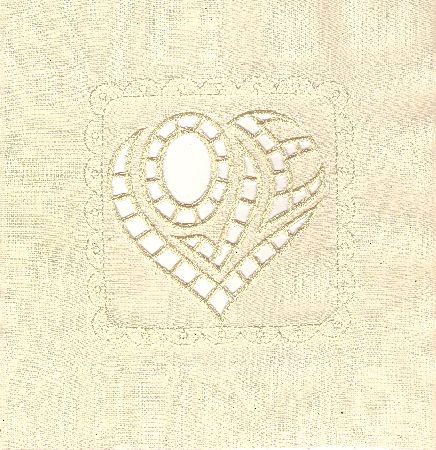
My experience and knowledge of fabric goes all the way back to Home Ec. class in Jr. High and High school. I vividly remember my teacher in 8th grade Home Ec. telling how important it is to make sure that we begin by straightening the grain of woven fabrics before we begin to cut out a pattern.
One thing that I personally believe though, is purchase the best fabric you can afford. Judy also mentioned using good fabric. The art/craft of quilting is a lengthy process. The things we make, bed covers, wall hangings, clothing, or whatever, can and will become heirlooms. Be sure that you use fabrics will last longer than the time you spend making them. Good fabrics do not come from discount department stores. Quilt shops are the best place to get the best fabrics. If you can’t find a shop in your area, look on line. I know you all have the internet, or you wouldn’t be reading this blog. Quilt shops are everywhere, (except where I live. My closest quilt shop is an hour to an hour and a half from where I live). Go online and select your favorite browser. Type in quilt, quilt shops, quilting, quilt patterns, quilt fabrics, quilt hints, quilt notions, quilt tools . . . get the message? Just put the word QUILT in front of any other word you are interested in. I have little doubt that "something" will come up. I seldom get 0 results when I look for quilt related things. Another suggestion, type in just the word fabrics, then type in quilt fabrics. I’ll bet you’ll get more and better results with quilt fabrics than with just fabrics. You can find quilt shops in a similar way. Just type in the name of your town and state/country, plus quilt shops and "click", it will tell you about shops that are near you. Example: New York City, NY+quilt shops.
It is important, however, to follow the instructions of your class instructor in preparing the fabric before you begin the cutting process. There are many and varied opinions on whether or not to prewash fabrics. I have found much less trouble with top quality fabrics than I have had with cheap ones. I seldom, prewash fabrics, unless they are dark colors that I have experienced fading problems, like dark blue, black and red. Go with your gut feelings about prewashing. If you usually do it, continue, if not, don’t it’s up to you. So far, I’ve been fortunate about fading and bleeding problems.
Try a little test when you go shopping for fabrics. First, if you can, go to a quality quilt shop. Most of them carry 100% cotton fabrics for quilting (more on that later) Get a piece of almost any fabric in the shop. Hold it up to the light. See how closely woven the fiber/threads are in the weave of the fabric. Now, on your way to lunch, stop by that well-known discount department store. Check out the fabric department there, (if they still carry fabrics.) Go to their clearance table and pick up a piece of fabric. Hold it up to the light and see the difference in the weave. If you cannot see the difference, head straight to your eye doc, or let me know. There IS a difference in quality. 100% cotton fabric . . . There is also a big difference in all cotton fabric and poly/cotton blends. The 100% cotton fabric is by far the easier to work with for quilting. It has a slight stretch of the crosswise grain. If you hold a piece of cotton fabric with the selvages* in each hand, hold it up and give it a little "tug", you will feel just a little bit of give in the cross wise grain. If you hold a piece of poly/cotton blend in the same way, there will be no give. The polyester in the blend makes the weave of the fabric very stable, so it is much harder to handle when you are piecing quilt blocks. The slight stretch of 100% cotton makes it easier to put the small pieces of a quilt block together, you can stretch a piece that is a little bit smaller measurement to fit the length of one that is a little bit larger. This won’t work with pieces that are more than 1/8 to 1/4 difference, but that tiny bit of stretch can make a world of difference in your ability to make the pieces fit.
Like Judy, I also say buy extra fabric. Recently, I found a really beautiful fabric on sale at an on line web site. When I read the description, it said it was 54 inches wide. When the fabric arrived, it was truly beautiful, red paisley print, just right for the blouse pattern I had in mind. I laid the pattern out on the fabric and there wasn’t enough for the collar. I checked the width of the fabric, and it was only 50 inches wide, just enough to make it too small for the pattern pieces. I called the web site, and it was all gone, sold quickly because of the sale price. I had to search out a compatible plain fabric to make a collar and cuffs. I haven’t had the heart to try it again. Sure wish I’d bought an extra half yard. That’s not the only time I’ve come up short, just the most recent.
Rotary cutter and cutting (referred to now as RC). Pat asked me to talk further about RC. WOW, what an open subject. As I said in my last post, the RC has become the friendliest and most dangerous tool in a Quilters sewing box. It could be described as a razor blade that rolls or a very sharp pizza cutter. To my knowledge, the "Olfa cutter" was the first one on the market. It was invented in Japan, and has become so useful that many other companies have begun to make their own versions. The old method of cutting quilt blocks was using a cardboard template, drawn by hand to the size and shape of the pieces in your block. Quilters often used a sandpaper board to stabilize the fabric while they draw around the cardboard with a pencil. Then came the scissors. The time intensive part of quilting is the drawing and the cutting. With the RC, came the speed that Quilters now know that they can produce quilts in a minimum of time compared to the old methods. Speed cutting and sewing methods have been developed by quilt designers for many of the old traditional patterns. You need only to look at the magazine racks or book store shelves to see the myriad of new patterns and instructions that are introduced every month. I use the ergonomic version of the original Olfa cutter (click here to view the product). It now has a better safety feature, and is shaped to be more comfortable and easier on your hands.

I said dangerous, didn’t I . . . Yes, the rotary cutter is way more dangerous than a non- user can imagine. When using an RC, never put it down without closing it first. It is sooo easy to forget that little click that will save your fingers again and again. If you’ve been sliced by an open RC, raise your hand. (I’m doin’ it) Also, get really acquainted with a new one if you change brands or buy one for the first time. The operation of an RC can be a little confusing at first. Learn how it works before you start out on that speed-pieced quilt you are planning. Treat ‘em kindly and save your skin.
Pat also asked for more about freezer paper. Pat, you certainly know how to ask wide-open questions. For anyone not familiar with freezer paper, it is a heavy white paper with wax and then plastic coating on one side, produced for many years by Reynolds Aluminum Company. With the influx of plastic bags, boxes and bowls for freezing foods, freezer paper became passe’. It was used to protect foods, mostly meat, for cold storage. With the decline of use, Reynolds stopped making it.
Along came the Quilters who had a stash of freezer paper in their pantry. "Gee whiz, I wonder if I could make this stuff stick to fabric with an iron . . . Yippee, it works! I’ll draw or trace a few flowers on it and cut ‘em out and sew ‘em on a quilt block." Then the Quilters told each other at the local quilting bee. "Look what I did with this ole’ freezer paper". Freezer paper also became a staple in the Quilters sewing box. This is where quilt guilds, quilt classes and quilting bees helped out the Reynolds Company. The ladies told each other and they all got together and wrote and called Reynolds (no emails then) and wonder of wonders, the company began to make it again.
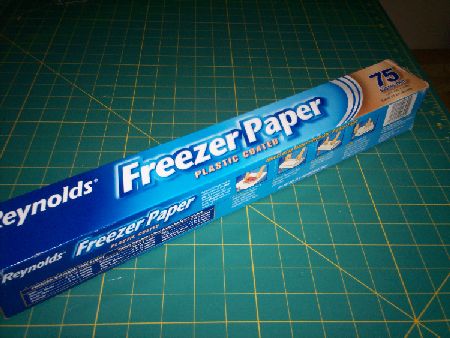
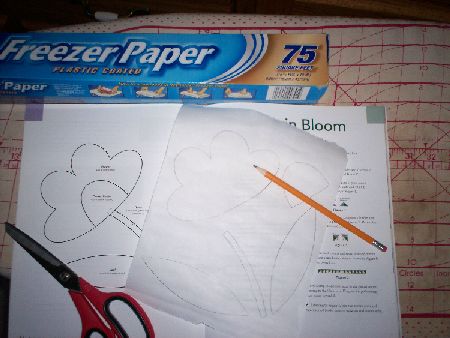
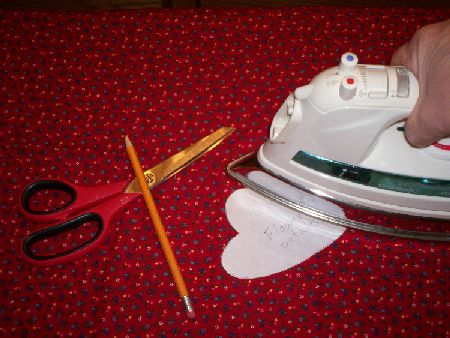
Freezer paper can be used for patchwork blocks. Example: the house block is often used in quilts. The house parts can be traced onto freezer paper, numbering each part to identify its placement, then she cuts the paper apart. The Quilter then irons the parts onto the various colored fabrics she has chosen for her house. She often uses a chalk pencil or blue marker to show the stitching lines. She carefully cuts out the fabric, leaving a precise 1/4 inch seam allowance around all the pieces. The parts are then sewn together by hand or machine, in order, using the number printed on each piece. The parts together are then used as a quilt block, with a contrasting border, around the house or by applique. Hope that’s clearer than mud. I have used freezer paper a lot for making tracing patterns for applique’. I have done a lot of "needle turn"* applique. Many of the blocks in this quilt were made using freezer paper, with both piecing and applique’ techniques.
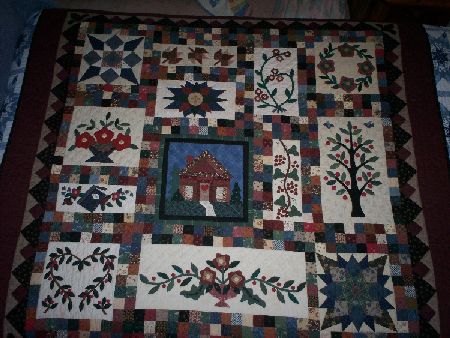
I have also made the mistake of thinking that some company had done quilters a favor and made a "better" freezer paper just for quilters. I really found out otherwise on two occasions. The folks at AnnTheGran.com asked me recently if ATG should order and stock a certain "new" freezer paper being marketed to quilters. I told them not to do that to you quilters, for this reason. The first roll of Reynolds that I bought was 150 sq. ft. roll. It lasted me more than ten years. The box fell apart before I used up the paper. The next box I bought was 75 sq. ft. I’ve been using it for years too, and it’s not gone. That brand costs an average of $3.50 a roll and can be purchased at most grocery and many hardware stores. I checked the price of "special" quilter paper. It was $8.95 for a package of 8 ½ x 11 sheets. There were 30 sheets per package. Logic tells me that it’s NOT a good buy. 11 inches is not long enough for some applique pattern pieces. By the roll, you get a very usable length of paper. Long ago, I bought a similar product, also made in small sheets. When I used it, it stuck so hard that I couldn’t get it off the fabric. I ruined a sizable amount of fabric with that stuff. Another time, I bought special paper for repairing and saving dressmaking patterns. It was nothing more than freezer paper with graph lines on it.
My theory about it is that some people know that they can make a lot of money by repackaging freezer paper and labeling it for quilters then charge a lot more. I get upset when someone makes "something better for Quilter". Show me that it’s a lot better and I might buy it, but when I find out it’s not better, I’m on the phone or the computer letting them know that I don’t like it.
Now that I have jumped down from my soap box, I think it is only honest to tell you that there is an advantage to those 8 ½ x 11 sheets. They do fit in the computer printer nicely, that’s how they market them. However, I had my first roll of paper before I found out about those special for Quilter brands and I have a trusty RC designated just for paper cutting. I can cut sheets in 8 ½ x 11 size that I can iron onto the back of fabric and make sheets to fit my printer. I don’t feel nearly as bad about messing up a piece that comes from a $3.50 roll of paper if I make a mistake. I use it to make labels for the back of my quilts, but it does take a little time to prepare the fabric so that the ink won’t run. I really don’t use a lot of it for labels. The satisfaction makes a difference. I also used some sheets with fabric already attached to the paper, made especially printing for labels. The fabric was so stiff when I pulled the paper off that I didn’t use it. With regular freezer paper the fabric stays just as soft as it was to start.
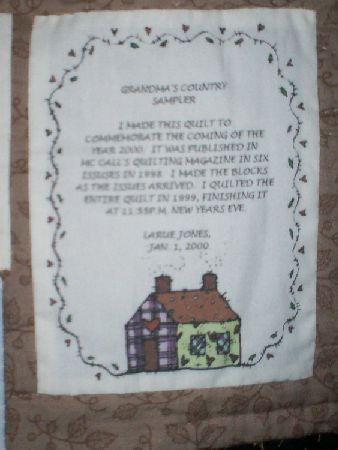
In another comment after my last post, someone said that sunlight can set the blue ink from water soluble pens. Another thought came to my mind. It seems to me that I remember leaving pen marks in fabric for a long time and the marks would not remove. I think that the marks in fabric will also set if they are not removed for a long time.
I’d like to add a few more thoughts, before I end my sojourn here. I was so touched by some of the comments in my last blog, especially, when Lin said she decided not to forsake quilting completely. I think I said before that I still have the leftover materials of several other things I have done. I’m sure that some of those oil paints have dried up, but I doubt that the basket weaving materials will ever go bad. Don’t even think about giving up one pursuit for another, you may come to regret that you have disposed of a lifetime love. Any of you ME’s who are thinking of taking up quilting should remember that one talent often is the catalyst for change to another. The color theory that you learned in an art class will certainly hold over in your brain to be used in quilting and ME. I learned in a religion class in high school to direct music. I have used that talent the rest of my life. I can read music, but I am not an accomplished musician. But I do have a deep appreciation for those who are great in the music field, because of the heavy responsibility of practice. Be the captain of your own destiny. You all have been given the talents you have for a reason that you may not know right now. Perhaps you will become the mentor for someone who really needs the things that you put on the shelf a year or five years ago. Talents are never lost on anyone. They may very well evolve into some other pursuit that will be worth a lifetime of trivial endeavors.
Stitches to you,
LaRue
Quilter’s Jargon:
Home economics
* classes on sewing, cooking, and home management usually held in high school. They have since it has been taken out the schools so the school systems can "economize" with their budgets, leaving the younger generation innocent about sewing, cooking and taking care of a home. (Not at all my idea of a good thing for the young ones)
Selvage*
The edge of fabric that does not ravel unless it’s cut.
Freezer paper*
freezer paper, it is a heavy white paper with wax and then plastic coating on one side, produced for many years by Reynolds Aluminum Company. It was used to protect foods, mostly meat, for cold storage, now used for various methods in quilting.
"Needle turn"
The applique’ method used when the stitcher uses the applique needle to turn the edge of the fabric under one length at a time before stitching it to a background fabric. Baltimore Album quilts are made with needle turn applique. (Google that and see some really gorgeous quilts.)